Black pasta with squid ink feels like an act of culinary rebellion—colorful, bold, and a bit mysterious. I remember the first time I saw squid ink pasta in a tiny seaside trattoria, thinking it was too pretty to eat. Now, it’s become my go-to for when I want to impress without fuss, especially when the pantry’s already stocked with a jar of ink.
Why this black pasta keeps pulling me back
The smoky, oceanic flavor lingers on the palate long after the plate’s empty. It’s a reminder of seaside adventures, of trying to capture the sea in a bowl. Every time I make it, I feel a rush—like I’m recreating a secret, underwater world to share.
Breaking down the key ingredients
- Black pasta (made with squid ink): Gives the dish its signature color and oceanic flavor, with a slightly briny, smoky note.
- Squid ink: The star—imparts depth, umami, and that inky black hue. Use a good-quality jar for richer flavor.
- Garlic: Adds aromatic pungency, balancing the sea-salty notes. Fresh is best for punch.
- White wine: Brightens the sauce with acidity and helps deglaze the pan, releasing caramelized bits.
- Red pepper flakes: Just a pinch for heat—adjust to your spice threshold.
- Olive oil: A good drizzle, for that silky base that melds flavors.
- Pasta water: Starchy and salty, it helps the sauce cling perfectly.
Tools & equipment: The essential kit for inky perfection
- Large pot: Boiling the pasta evenly and efficiently.
- Wide skillet or frying pan: Creating a deep, flavorful sauce that can coat the pasta.
- Tongs or pasta fork: Handling hot pasta without breaking it.
- Measuring cups & spoons: Accurately measuring wine, oil, and liquids.
- Chef’s knife: Finely chopping garlic and herbs.
Step-by-step: Making the inky black magic
Step 1: Fill a large pot with water, salt generously—think seawater. Bring it to a rolling boil, about 100°C (212°F).
Step 2: Add the black pasta, stirring immediately to prevent sticking. Cook for 8-10 minutes, until al dente.
Step 3: While pasta cooks, heat a tablespoon of olive oil in a wide skillet over medium heat—around 160°C (320°F).
Step 4: Add finely chopped garlic and red pepper flakes. Sizzle until fragrant, about 30 seconds.
Step 5: Pour in a splash of white wine, letting it reduce by half, about 2 minutes.
Step 6: Stir in squid ink, ensuring it melts into the wine, creating a deep, inky sauce.
Step 7: Drain pasta, reserving a cup of pasta water. Toss pasta into the ink sauce, adding a splash of water to loosen if needed.
Step 8: Cook together for 2 minutes, letting flavors meld.
Cooking checkpoints & tips to get it just right
- Pasta should be al dente—firm but not hard, with a slight bite.
- The ink sauce should be glossy and thick enough to coat the pasta evenly.
- Garlic and wine should smell fragrant but not burnt or harsh.
Common pitfalls & how to fix them
- Squid ink clumping or seizing when added to hot liquid.? IF THE INK SAUCE TURNS GRAINY, ADD A LITTLE MORE PASTA WATER AND STIR GENTLY.
- Overcooked pasta losing its bite.? IF PASTA OVERCOOKS, DRAIN EARLY AND TOSS IN A BIT OF ICE WATER TO STOP THE COOKING.
- Running the sauce too long, causing it to become watery.? IF THE SAUCE IS TOO THIN, SIMMER A FEW MINUTES UNTIL THICKENED.
- Lack of brightness or seasoning.? IF THE FLAVOR IS BLAND, ADD A PINCH OF SALT OR A SQUEEZE OF LEMON.
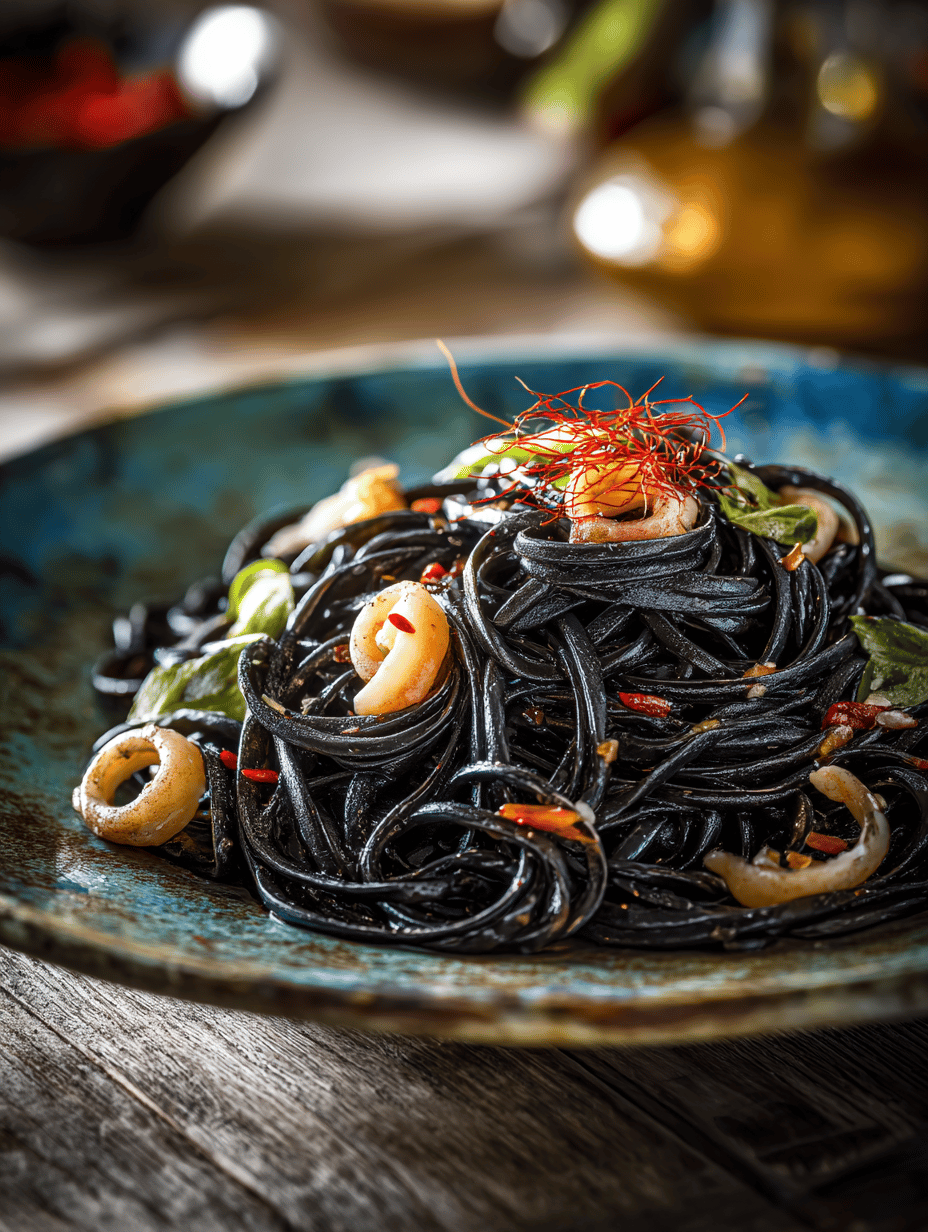
Black Pasta with Squid Ink
Ingredients
Equipment
Method
- Fill a large pot with water, salt generously to mimic seawater, and bring to a rolling boil.
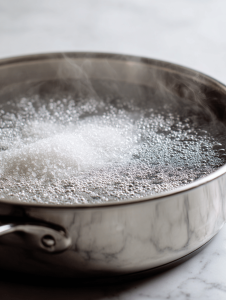
- Add the black pasta to the boiling water, stirring immediately to prevent sticking. Cook for 8-10 minutes until al dente, then drain, reserving about a cup of pasta water.
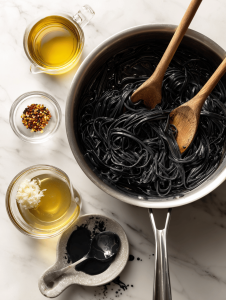
- While the pasta cooks, heat olive oil in a wide skillet over medium heat until shimmering and fragrant.
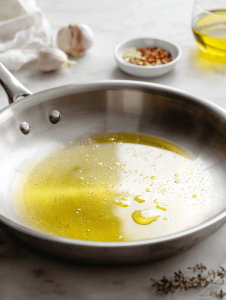
- Add the finely chopped garlic and red pepper flakes to the skillet, sizzling until the garlic is fragrant and lightly golden, about 30 seconds.
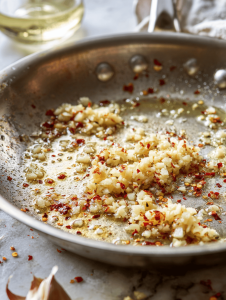
- Pour in the white wine, allowing it to bubble and reduce by half, about 2 minutes, which concentrates the flavor and releases a delightful aroma.
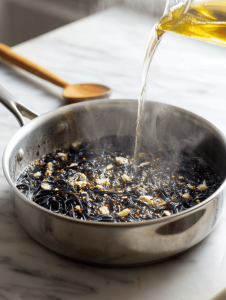
- Add the squid ink to the skillet, stirring constantly to melt it into the wine, creating a deep, inky sauce that coats the bottom of the pan.
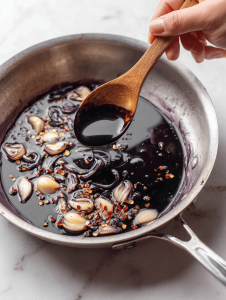
- Toss the drained pasta into the ink sauce, stirring gently to coat each strand evenly. Add a splash of reserved pasta water if the sauce seems too thick or sticky.
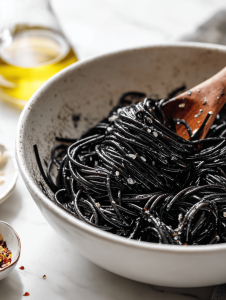
- Cook the pasta and sauce together for about 2 minutes, allowing the flavors to meld and the sauce to thicken slightly, glossy and clingy.
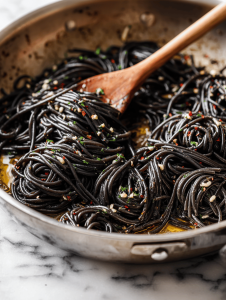
- Remove from heat and serve immediately, garnished with fresh herbs or a squeeze of lemon if desired, for a bright contrast to the rich ink flavor.
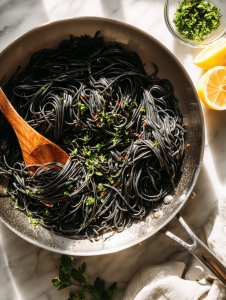
Leave a Reply